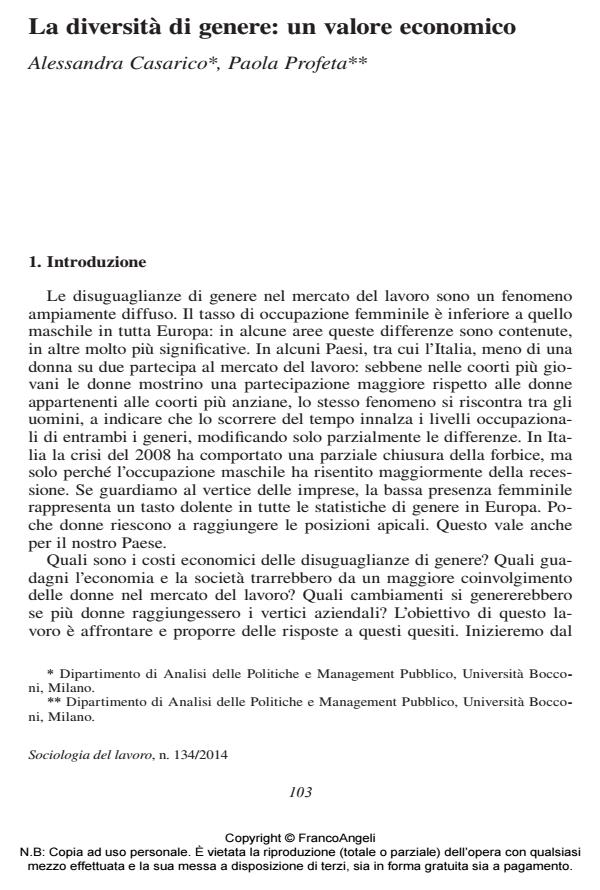Gender diversity as an economic value
Journal title SOCIOLOGIA DEL LAVORO
Author/s Alessandra Casarico, Paola Profeta
Publishing Year 2014 Issue 2014/134 Language Italian
Pages 13 P. 103-115 File size 92 KB
DOI 10.3280/SL2014-134006
DOI is like a bar code for intellectual property: to have more infomation
click here
Below, you can see the article first page
If you want to buy this article in PDF format, you can do it, following the instructions to buy download credits

FrancoAngeli is member of Publishers International Linking Association, Inc (PILA), a not-for-profit association which run the CrossRef service enabling links to and from online scholarly content.
What are the economic costs of gender-based disparities? What would the economy and society at large gain from a wider involvement of women in the labour market? What changes would more women in top positions generate? The paper addresses these issues grounding its analysis in the economic literature. It focuses on the policies which can promote the role of women in economic decision making concentrating on gender quotas. In particular, after considering the pros and cons of the introduction of this type of policy, the paper discusses the Italian law introduced in 2011 and its first effects, highlighting how the Italian law can serve as a blueprint for other countries which want to design interventions to promote female presence in leadership positions. The conclusion suggests that viewing equal opportunities between men and women not only as an important matter of equal rights but also a matter of higher growth and welfare for all may help in building consensus to move the issue to the top of the political agenda.
Keywords: Gender gaps, growth, performance, gender quotas, boards of directors
- Adams R.B., Ferreira D. (2009). Women in the boardroom and their impact on governance and performance. Journal of Financial Economics, 94: 291-309. DOI: 10.1016/j.jfineco.2008.10.007
- Adams R., Ragunathan V. (2013). Lehman Sisters. University of New South Wales, mimeo.
- Ahern K., Dittmar A. (2012). The changing of the boards: the impact on firm valuation of mandated female board representation. Quarterly Journal of Economics, 127, 1: 137-97. DOI: 10.1093/qje/qjr049
- Amidani L., Casarico A., D’Amico M., Profeta, P., Puccio A. (2014). Women Directors. The Italian way and beyond. Palgrave MacMillan, di prossima pubblicazione.
- Amore M.D., Garofalo O., Minichilli A. (2013). Gender interactions within the family firm. Management Science, forthcoming.
- Baltrunaite A., Bello P., Casarico A., Profeta P. (2012). Gender quotas and the quality of politicians. CESifo working paper n. 3734. Bertrand M., Black S., Lleras-Muney A., Jensen S. (2012). Breaking the glass ceiling: The effect of board quotas on female labor market outcomes in Norway, Slides presentation in Bocconi.
- Casarico A., Profeta P. (2009). Donne e lavoro: quali politiche? Aggiornamenti Sociali, 5: 343-352.
- Casarico A., Profeta P. (2010). Donne in attesa. L’Italia delle disparità di genere. Milano: Egea.
- Del Boca D., Flinn C. (2012). Endogenous household interaction. Journal of Econometrics, 166, 1: 49-65. DOI: 10.1016/j.econom.2011.06.005
- Duflo E. (2012). Women’s empowerment and economic development. Journal of Economic Literature, 50, 4: 1051-79. DOI: 10.1257/jel.50.4.1051
- Engelstad F., Teigen M. (2012). Firms, Boards and Gender quotas: Comparative perspectives. Bingley: Emerald.
- European Commission (2010). More women in senior positions. Key to economic stability and growth. Directorate-General for Employment, Social Affairs and Equal Opportunity.
- Ferrera M. (2008). Il fattore D: perché il lavoro delle donne farà crescere l’Italia. Milano: Mondadori.
- Gamba M., Goldestein A. (2009). The gender dimension of business elites. Italian women directors since 1934. Journal of Modern Italian Studies, 2: 199-225. DOI: 10.1080/13545710902826469
- Matsa D.A., Miller A.R. (2013). A Female Style in Corporate Leadership? Evidence from Quotas. American Economic Journal: Applied Economics, 5, 3: 136-96. DOI: 10.1257/app.5.3.136
- Niederle M., Vesterlund L. (2010). Explaining the gender gap in math test scores: The role of competition. The Journal of Economic Perspectives, 24, 2: 129-44. DOI: 10.1257/jep.24.2.129
- Nygaard K. (2011). Forced Board Changes. Norwegian School of Economics and Business Administration. SAM 5. Discussion Paper.
- Olivetti C., Petrongolo B. (2008). Unequal Pay or Unequal Employment? A Cross-country Analysis of Gender Gaps. Journal of Labor Economics, 26, 4: 621-654. DOI: 10.1086/589458
- Rose C. (2007). Does female board representation influence firm performance? The Danish evidence. Corporate Governance. An International Review, 2, 404-13. DOI: 10.1111/j.1467-8683.2007.00570.x
- Schwartz-Ziv M. (2012). Does the gender of directors matter? Working Paper Available at SSRN 1868033.
- Smith N., Smith V.G., Verner M. (2006). Do women in top management affect firm performance? A panel study of 2500 Danish firms. International Journal of Productivity and Performance Management, 7, 569-93. DOI: 10.1108/17410400610702160
- Wang M., Kelan E. (2013). The Gender Quota and Female Leadership: Effects of the Norwegian Gender Quota on Board Chairs and CEOs. Journal of Business Ethics Vol. 117, 449966. DOI: 10.1007/S10551-012-1546-5
- Wittenberg-Cox A. (2010). How women mean business: A step by step guide to profiting from gender balanced business. Wiley.com.
- World Economic Forum (2013). The Global Gender Gap Report, 2013. Available on line at: www.weforum.org/reports/global-gender-gap-report-2013.
Alessandra Casarico, Paola Profeta, La diversità di genere: un valore economico in "SOCIOLOGIA DEL LAVORO " 134/2014, pp 103-115, DOI: 10.3280/SL2014-134006